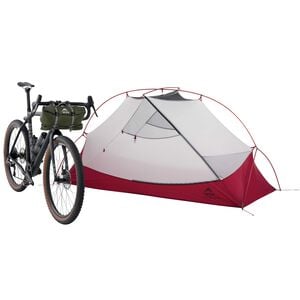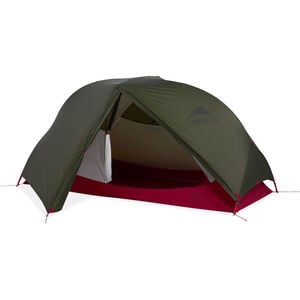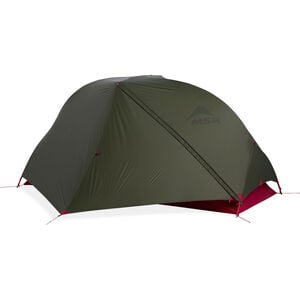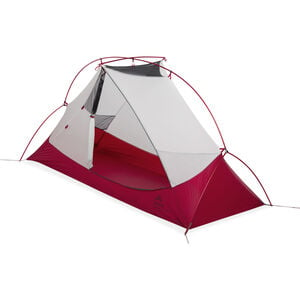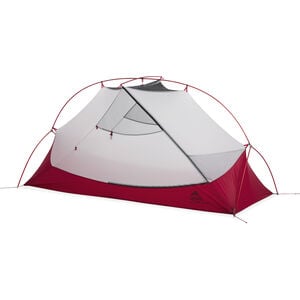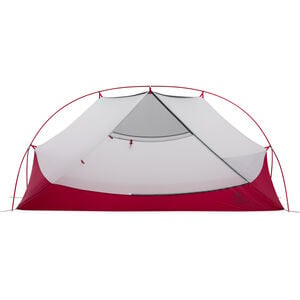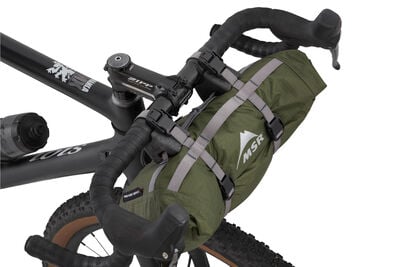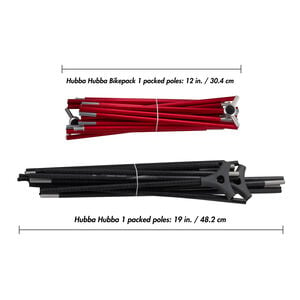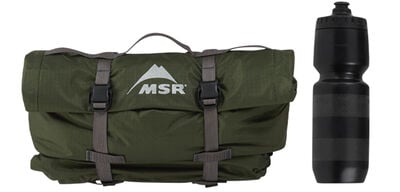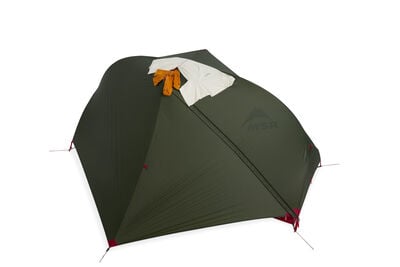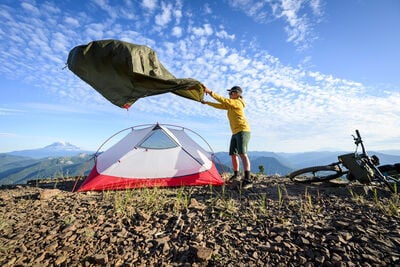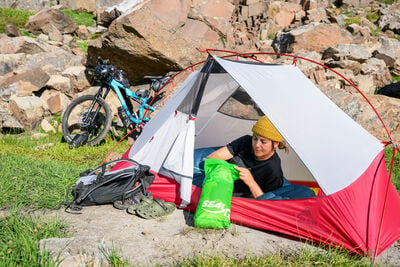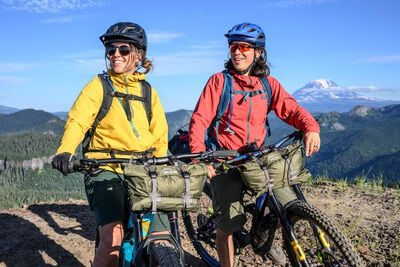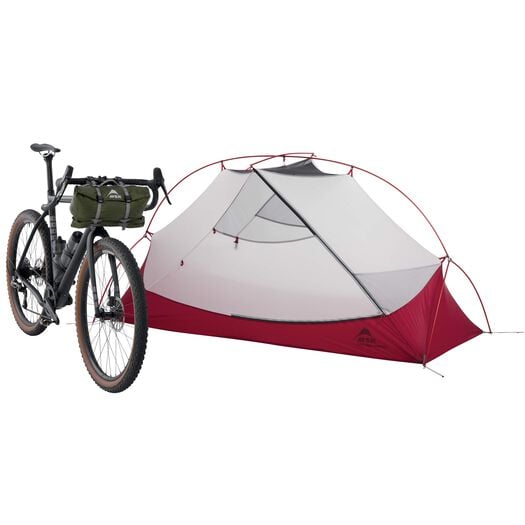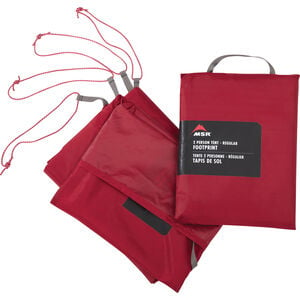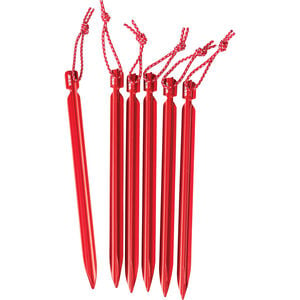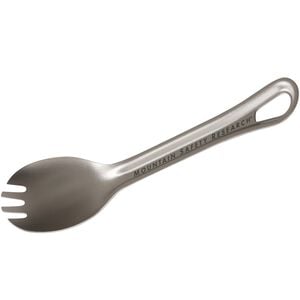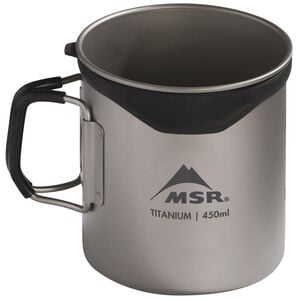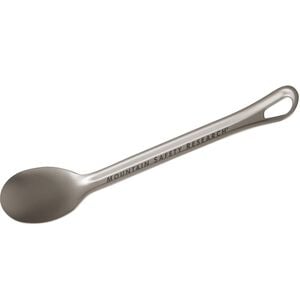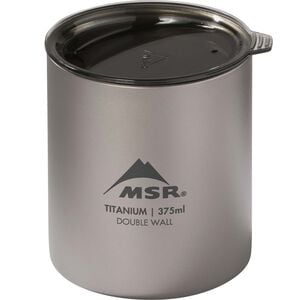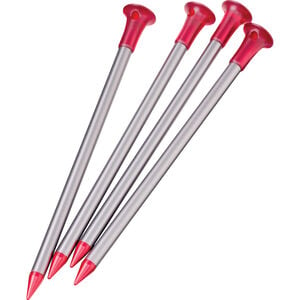Conçue pour les cyclistes férus d’aventure, en tout-terrain ou sur le bitume, la nouvelle tente Hubba Hubba Bikepack 1 personne a été minutieusement pensée pour la vie sur deux roues. Des fonctionnalités bien pensées que tous les cyclistes vont remarquer, associées à un volume intérieur appréciable, font de cette tente la meilleure de sa catégorie.
L’intérieur : le tapis de sol rectangulaire (sans rétrécissement aux pieds) offre assez de place pour tout votre équipement et la hauteur intérieure de 97 cm (38 po) vous permet de vous asseoir confortablement. La toile intérieure combine moustiquaire et tissu pour assurer une bonne ventilation en vous assurant de l’intimité et la protection contre les intempéries. Les fermetures à glissière de la porte de la tente sont droites et s’utilisent facilement d’une seule main. De plus, elles se terminent en un seul point : vous savez toujours où ouvrir la porte, même dans l’obscurité. Les pochettes adaptées à vos équipements électroniques sont dotées de passages pour les cordons des chargeurs. Les grandes poches de l’espace de rangement suspendu sont parfaites pour accéder rapidement aux gants, lunettes de soleil et autres objets que vous voulez garder sous la main. Une corde à linge intérieure et une corde à linge extérieure optionnelle (incluse) offrent suffisamment d’espace pour faire sécher vos vêtements humides.
L’extérieur : la Hubba est rectangulaire ; vous pouvez donc la monter rapidement, une bénédiction quand vous essayez de battre de vitesse un orage inattendu. Les arceaux DAC robustes et légers sont assez courts quand ils sont repliés pour les attacher facilement au guidon. Ces arceaux plus courts une fois repliés sont aussi parfaits pour les kayakistes qui veulent glisser facilement leur tente dans la soute pour leurs sorties sur plusieurs jours. Avec un revêtement imperméable et des coutures renforcées étanches, la Hubba est stable et vous protège de la pluie, tout en confort. Le double-toit vert camouflage intègre un grand vestibule pour ranger tout l’équipement cycliste que vous ne voulez pas garder à l’intérieur. La porte du vestibule permet un passage facile ; elle est dotée d’une gouttière StayDry™ qui empêche l’eau de s’égoutter sur vous et votre équipement ainsi que d’un évent d’aération avec béquille pour améliorer la ventilation.
La sacoche de guidon : la sacoche de rangement étanche pour le guidon, conçue avec soin, s’adapte à tous les vélos, qu’ils soient équipés d’un guidon plat ou cintré, type route. Les cales d’espacement optionnelles incluses maintiennent la sacoche à distance du guidon pour ne pas perdre un espace précieux pour vos accessoires. La sacoche est également dotée d'un marquage rétro-réfléchissant pour une meilleure visibilité sur la route, et de boucles pour attacher des accessoires supplémentaires. Sa petite taille permet de la ranger facilement dans des sacoches, une sacoche de cadre ou un sac à dos.
En résumé : excellente stabilité sur le vélo, confort en camping, riche en fonctionnalités, la tente Hubba Hubba Bikepack deviendra rapidement votre nouveau chez-vous favori quand vous partez loin de tout.
- Légèreté :un poids minimal de 900 g (2 lb 1 oz).
- Sacoche de guidon étanche : conçu pour s’attacher sans problème à un guidon plat ou cintré de route, le sac est profilé, ses coutures sont scellées et il est imperméable.
- Cales d’espacement pour le guidon : des cales amovibles permettent de libérer de la place entre le sac et le guidon pour les mains ou pour les accessoires. Un cordon élastique sur le tube de direction assure la stabilité du sac en tout-terrain.
- Arceaux courts : conçus avec des segments plus courts, les arceaux DAC robustes se plient tout petit pour se glisser facilement entre les cocottes au guidon (longueur repliés : 30 cm/12 po).
- Petit volume repliée : la tente est conçue pour un volume minimal une fois repliée, ce qui vous permet de la loger dans un petit coin de la sacoche, de la sacoche de cadre ou du sac à dos.
- Espace intérieur maximal :toile de sol rectangulaire et excellente hauteur sous plafond (97 cm/38 po) ; grand vestibule avec porte d’entrée sur le côté, parfait pour tout votre équipement.
- Étanchéité : revêtement polyéther uréthane sur les tissus et coutures renforcées étanches pour la protection contre les intempéries.
- Double-toit fonctionnel :une grande porte StayDry™ avec gouttière intégrée et un évent d’aération avec béquille pour une meilleure ventilation.
- Étendage pour les affaires mouillées : les cordes à linge intérieures et extérieures (optionnelles) ainsi que les poches de rangement surdimensionnées facilitent le séchage de vos affaires trempées par la sueur ou par la pluie, pour un départ bien au sec le lendemain.
- Pochettes pratiques pour le matériel électronique : passages pratiques pour les cordons dans toutes les pochettes.
- Montage et rangement simples :avec son système unifié d’arceaux à emboîtement central et la symétrie du concept, elle se monte très rapidement. Son sac de transport est très compact.
- Moustiquaire pour une vue imprenable sur les étoiles : montez uniquement la toile intérieure et endormez-vous en regardant les étoiles par la moustiquaire au-dessus de votre tête.
- Robuste jusque dans les petits détails : pièces de renfort, attaches des haubans surpiquées, œillets en métal anodisé pour les boucles d’attache des piquets.
Comprend :toile intérieure, double-toit, arceaux, piquets, haubans, sac de transport, cordes à linge, instructions de montage.
Compatible avec la toile de sol Universal 1 personne, vendue séparément.
